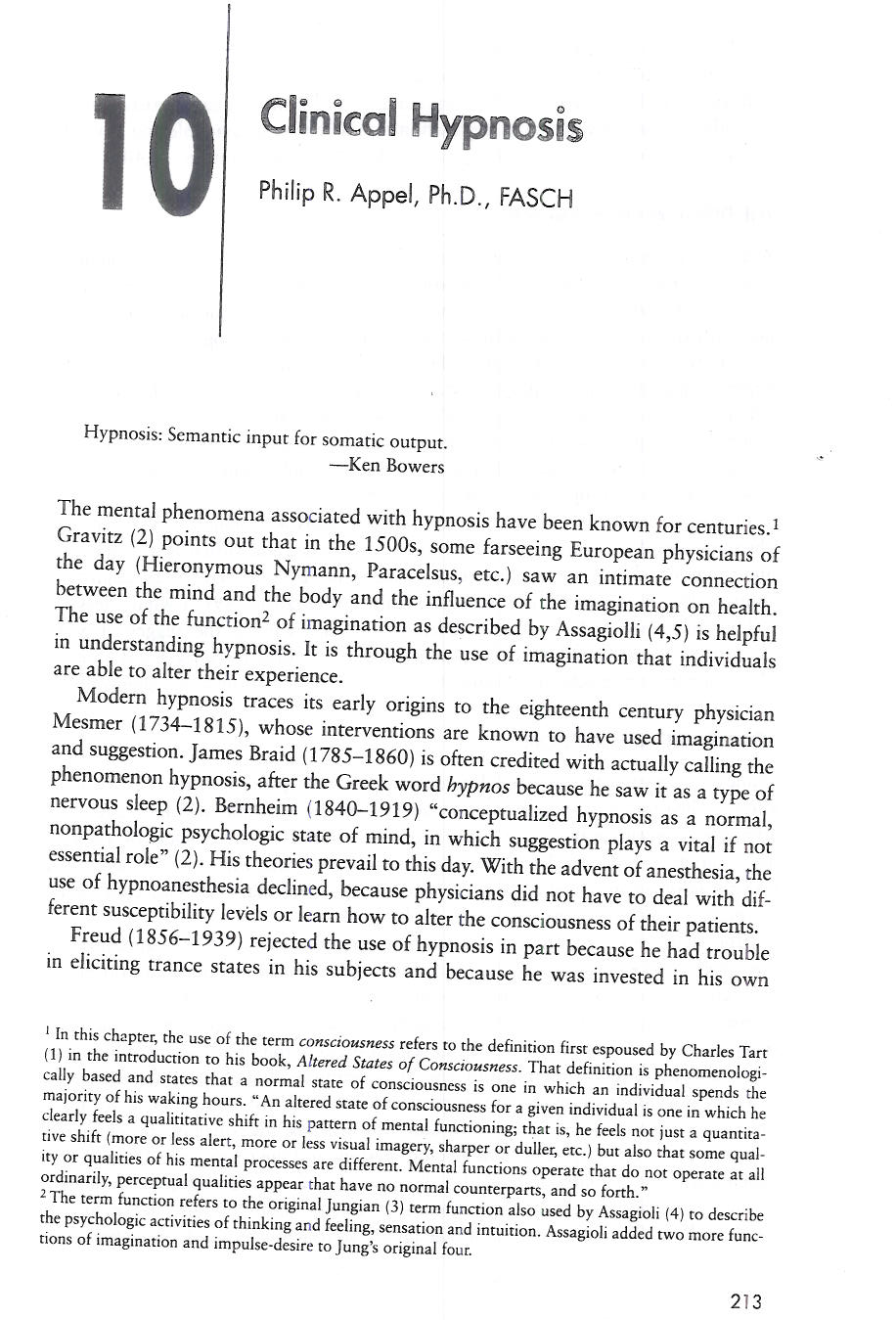AMERICAN JOURNAL OF CLINICAL HYPNOSIS
2020, VOL. 62, NO. 4, 330–343
https://doi.org/10.1080/00029157.2019.1709152
A Philosophical Approach to the Rehabilitation of the Patient with Persistent Pain
Philip R. Appel
MedStar National Rehabilitation Hospital, Washington DC, USA
ABSTRACT
The use of hypnosis to promote hypnoanalgesia has a long history and has been written about anecdotally as well as having been researched in the last several decades. Research has been both clinical in nature and, in the laboratory, trying to understand the brain physiology and processes involved. This article is not about a review of the research. It is about sharing what I have learned to do clinically using hypnosis to treat patients with persistent pain over the last 40 plus years. Due to the restraints of limited space, I can only discuss the various techniques briefly. I will describe a philosophical perspective that has served me well and driven my approach to treatment. I will discuss the concept of self-regulation training along the dimensions of Sensation, Affect, Cognition, and Behavior and share how hypnosis has been incorporated in working within each of those aspects of experiencing.

AMERICAN JOURNAL OF CLINICAL HYPNOSIS
2021, VOL. 63, NO. 2, 112–127
https://doi.org/10.1080/00029157.2020.1742086
Post-traumatic stress in the medical setting
Philip R. Appel
MedStar National Rehabilitation Hospital, Washington DC, USA
ABSTRACT
This article addresses the prevalence of posttraumatic stress arising from serious illness and injury. Its purpose is to underscore the importance of assessment and treatment of this population. The article reviews literature about patient stress responses to intensive
care experiences and hospitalization. Above all, serious illness and injury hamper the individual’s ability to maintain their ongoing lifestyle and interpersonal relationships; the experience raises the specter of vulnerability and mortality and can obstruct the experience of a familiar “self”. Issues to be assessed and areas to be addressed therapeutically using hypnosis are suggested.

American Journal of Clinical Hypnosis Copyright 2005 by the American Society of Clinical Hypnosis 48:2-3, October 2005/January 2006
Pain Reduction Is Related to Hypnotizability but Not to Relaxation or to Reduction in Suffering: A Preliminary Investigation
Philip R. Appel
Joseph Bleiberg National Rehabilitation Hospital, Washington, DC The present study examined the facilitation of pain reduction through the use of a pain reduction protocol. The protocol emphasized converting pain sensations into visual and auditory representations, which then were manipulated through therapeutic suggestion. Hypnosis was not mentioned in the intervention, minimizing creation of expectancy effects related to hypnosis. At the conclusion of the study, the Stanford Clinical Hypnotic Scale was administered. Measures of relaxation and reduction of suffering were not related to hypnotizability. However, pain reduction was significantly related to hypnotizability (r = .55, P < .001). High hypnotizables had a greater reduction in pain than low hypnotizables, even though both had equivalent degrees of relaxation.
Keywords: Hypnotizability, pain, relaxation, suffering


American Journal of Clinical Hypnosis, 56: 249–268, 2014
Copyright © American Society of Clinical Hypnosis
ISSN: 0002-9157 print / 2160-0562 online
DOI: 10.1080/00029157.2013.831744
Psychosynthesis: A Transpersonal Model for Hypnotically Mediated Psychotherapy
Philip R. Appel
MedStar National Rehabilitation Hospital, Washington, DC, USA
Psychosynthesis is one of the first Western transpersonal models of personality and psychotherapy. It was developed in 1910 by the Italian psychiatrist Roberto Assagioli. In this article, basic constructs involving the realms of consciousness, subpersonalities, and the importance of the will, and the neo-Jungian functions, will be introduced and related to the practice of hypnotically mediated psychotherapy. That which makes this model unique is its recognition of the human spirit and how that impacts consciousness and its inclusion as an important element to be included in therapy. A guideline for selecting interventions based upon the patient’s symptom will be described as well as a discussion of some of the therapy techniques associated with this model.
Keywords: Assagioli, hypnosis, psychosynthesis, transpersonal

In Journal of Psychiatric Medicine Vol. 10. No.4 1992

Book chapters
In Vol. 3 Current Thinking and Research in Brief Therapy: Solutions, Strategies, Narratives

In Complementary and Alternative Medicine in Rehabilitation

In The Management of Stress and Anxiety in Medical Disorders

In Alternative Medicine and Rehabilitation: A guide for Practitioners

In Handbook of Medical and Psychological Hypnosis: Foundations, Applications and Professional Issues

Book Reviews
Appel, P.R. Book Review. Narrative, Pain, and Suffering. New England Journal Of Medicine. Vol. 353: No. 15 p. 1637 October (2005)
Appel, P.R. Book Review. Healing Images: The Role of Imagination in Health. American Journal of Clinical Hypnosis, Vol. 45, No. 3 pp.254-256 (2003)
Appel, P.R. Book Review. Trauma and Survival: Post-Traumatic and Dissociative Disorders in Women. American Journal of Clinical Hypnosis, Vol. 36, No. 4 pp. 293-294 (1994)
